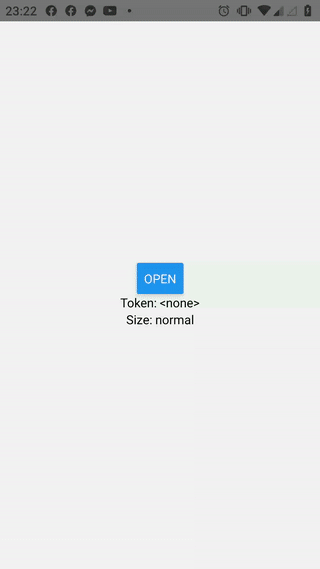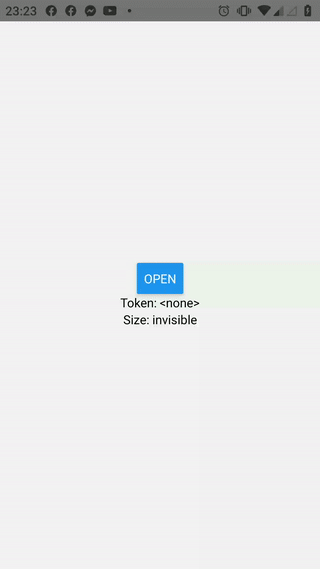Users have recently observed a significant increase in "high risk requests" when using reCAPTCHA solution with WebView. Upon further investigation, we found that the official documentation advises against using WebView-based implementations for reCAPTCHA on iOS and Android.
Now, Google recommends using their first-party solution for React Native, which is intended for enterprise use.
You can find more details and the discussion here.
A reCAPTCHA library for React Native (Android and iOS) that works.
Looking for React DOM version?
| Normal | Invisible |
|---|---|
 |
 |
Try the Online demo.
yarn add react-native-recaptcha-that-works react-native-webviewOr
npm i -S react-native-recaptcha-that-works react-native-webviewSee the react-native-webview Getting Started Guide.
With JavaScript:
import React, { useRef } from 'react';
import { View, Button } from 'react-native';
import Recaptcha from 'react-native-recaptcha-that-works';
const App = () => {
const recaptcha = useRef();
const send = () => {
console.log('send!');
this.recaptcha.current.open();
}
const onVerify = token => {
console.log('success!', token);
}
const onExpire = () => {
console.warn('expired!');
}
return (
<View>
<Recaptcha
ref={recaptcha}
siteKey="<your-recaptcha-public-key>"
baseUrl="http://my.domain.com"
onVerify={onVerify}
onExpire={onExpire}
size="invisible"
/>
<Button title="Send" onPress={send} />
</View>
);
}Or with TypeScript:
import React, { useRef } from 'react';
import { View, Button } from 'react-native';
import Recaptcha, { RecaptchaRef } from "react-native-recaptcha-that-works";
// ...
export const Component: React.FC = () => {
const recaptcha = useRef<RecaptchaRef | null>(null);
const send = () => {
console.log('send!');
recaptcha.current?.open();
};
const onVerify = (token: string) => {
console.log('success!', token);
};
const onExpire = () => {
console.warn('expired!');
}
return (
<View>
<Recaptcha
ref={recaptcha}
siteKey="<your-recaptcha-public-key>"
baseUrl="http://my.domain.com"
onVerify={onVerify}
onExpire={onExpire}
size="invisible"
/>
<Button title="Send" onPress={send} />
</View>
);
};For more details, see the Sample Project.
| Name | Value | Default | Description |
|---|---|---|---|
| headerComponent | React Element |
A component to render on top of Modal. | |
| footerComponent | React Element |
A component to render on bottom of Modal. | |
| loadingComponent | React Element |
A custom loading component. | |
| style | ViewStyle |
Customize default style such as background color. | |
| modalProps | ModalProps | Override the Modal props. | |
| webViewProps | WebViewProps | Override the WebView props. | |
| lang | string |
Language code. | |
| siteKey | string |
(Required) Your Web reCAPTCHA site key. (The Web key must be used, not for Android) | |
| baseUrl | string |
(Required) The URL (domain) configured in the reCAPTCHA console setup. (ex. http://my.domain.com) (See also #34) | |
| size | 'invisible', 'normal' or 'compact' |
'normal' |
The size of the widget. |
| theme | 'dark' or 'light' |
'light' |
The color theme of the widget. |
| onLoad | function() |
A callback function, executed when the reCAPTCHA is ready to use. | |
| onVerify | function(token) |
(Required) A callback function, executed when the user submits a successful response. The reCAPTCHA response token is passed to your callback. | |
| onExpire | function() |
A callback function, executed when the reCAPTCHA response expires and the user needs to re-verify. Only works if the webview still open after onVerify has been called for a long time. |
|
| onError | function(error) |
A callback function, executed when reCAPTCHA encounters an error (usually network connectivity) and cannot continue until connectivity is restored. If you specify a function here, you are responsible for informing the user that they should retry. | |
| onClose | function() |
A callback function, executed when the Modal is closed. | |
| recaptchaDomain | string |
www.google.com |
The host name of the reCAPTCHA valid api. See detail. |
| gstaticDomain | string |
www.gstatic.com |
Customize reCAPTCHA gstatic host. |
| hideBadge | boolean |
false |
When size = 'invisible', you are allowed to hide the badge as long as you include the reCAPTCHA branding visibly in the user flow. See detail. |
| enterprise | boolean (enterprise) |
false |
Use the new reCAPTCHA Enterprise API. Note: for enterprise you need to choose the size when creating the siteKey. |
| action | string (enterprise) |
An additional parameter for specifying the action name associated with the protected element for reCAPTCHA Enterprise API. |
Note: If lang is not set, then device language is used.
| Name | Type | Description |
|---|---|---|
| open | function |
Open the reCAPTCHA Modal. |
| close | function |
Close the reCAPTCHA Modal. |
Note: If using size="invisible", then challenge run automatically when open is called.
This is a bug in react-native-webview (more details #65). PR opened in react-native-webview/react-native-webview#3615.
This package utilizes the web version of reCAPTCHA v2, so in the siteKey prop you need to use the site public key from the reCAPTCHA console.

Create new reCAPTCHA v2 here https://www.google.com/recaptcha/admin/create
And the baseUrl prop must be a valid domain set in the Domains section.
<Recaptcha siteKey="abc123" baseUrl="http://mysite.com" />
New features, bug fixes and improvements are welcome! For questions and suggestions, use the issues.
The MIT License (MIT)
Copyright (c) 2020 Douglas Nassif Roma Junior
See the full license file.





